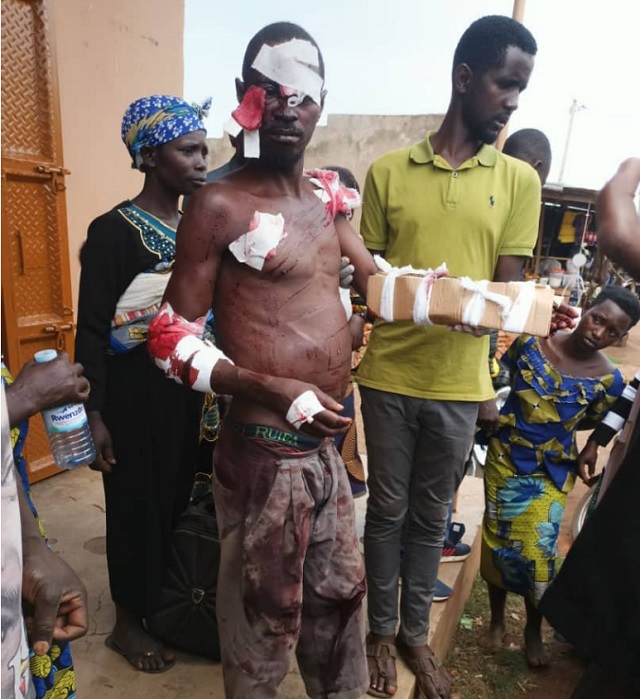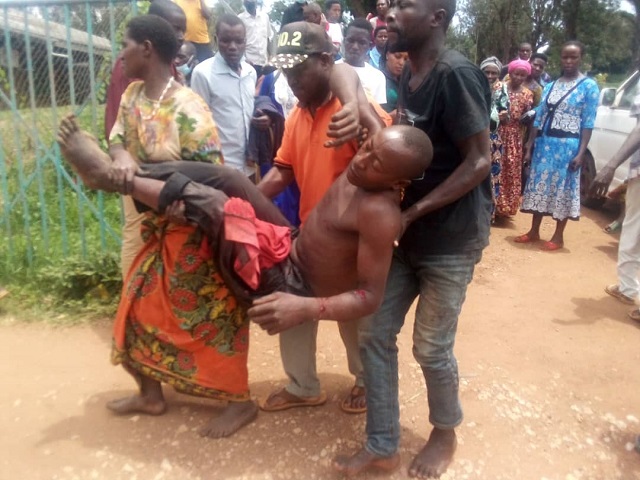
Why shooting, skinning and sharing of lion meat sent shockwaves among local conservationists
Kampala, Uganda | RONALD MUSOKE | On April 8, a stray juvenile lion that had spent days killing and eating people’s livestock in several villages in the western Uganda district of Kagadi was shot dead by soldiers of the Uganda Peoples Defence Forces (UPDF).
The lion was gunned down during a joint operation involving the Uganda police, the UPDF and Uganda Wildlife Authority (UWA)—the agency in charge of conservation in the country. According to a statement from UWA, the lion had killed an unspecified number of livestock including; goats, cattle and pigs and had been sighted by several people.
The agitated villagers overpowered security and skinned the lion and shared its meat. It remains unclear what the villagers did with the meat.
George Owoyesigire, the Acting Commissioner in charge of wildlife conservation at the Ministry of Tourism, Wildlife and Antiquities told The Independent on April 13 that the skinning of the lion and sharing of its meat left many conservationists worried.
The culture of eating cat meat has never been recorded anywhere in Uganda. So this incident worries us,” he told The Independent.
“Some think the people took home the meat to eat it while others think the meat could have been kept for other purposes, especially rituals.” “It is an isolated case but we still need to investigate it,” he told The Independent.
Dr. Gladys Kalema Zikusoka, the founder and chief executive officer of Conservation Through Public Health, a local conservation non-profit that promotes harmonious co-existence between wildlife and the communities that neighbour wildlife protected areas also told The Independent that she found the Kagadi incident “shocking” because most Ugandan communities would not do it.
“I know that lions kill people’s livestock which often makes them angry but even in Queen Elizabeth National Park where there has been a lot of confrontation between the lions and frontline communities, I have never seen anything like it.”
“Obviously, the Kagadi people don’t know the number of wildlife diseases they could pick up from eating lion’s meat,” Dr. Zikusoka said.
Another conservationist who did not want to disclose his name for fear of antagonizing regional relations told The Independent that the culture of eating cat meat such as the one of this lion could be as a result of refugees from neighbouring countries who get assimilated into Ugandan communities through intermarriages.
Kagadi District is not far away from Kyangwali Refugee Settlement which has a sizeable population of refugees from Congo, South Sudan, and other neighbouring countries.

Villagers’ experiences
On the fateful day the lion was sighted, UWA staff stationed 30km away at the UWA satellite outpost near Muhoro town moved quickly to rescue the carnivore and possibly take it back into a protected area but upon reaching the village, they found an already charged community who were armed with machetes, spears and clubs and were searching for the lion. The lion had mauled to near death three men that day.
“The lion was already stressed and enraged by the presence and noise of a huge crowd that was following the lion with the intention to kill it,” a statement from UWA published on April 9 reads in part.
Even when the people were asked by security to give way and let the UWA staff and police handle the problem animal, more crowds gathered due to the noise and alarm that was being raised.
One soldier sighted the lion and tried to shoot it but it unleashed one giant leap towards him and injured him. Fearing the worst, another soldier shot and killed the lion to save his colleague.
The crowd immediately overpowered security and skinned the lion and shared its meat. UWA pleas to hand over the carcass fell on deaf ears. UWA said in a statement that it only managed to secure the skin and the head from the carcass which were taken to police for record purposes and further investigations.
ASP Moses Muziima Kiconco, the District Police Commander for Kagadi said the lion had terrorized the community for several days. John Musherure who said his three goats had been devoured by the lion told The Independent that the community had already decided to kill the lion.
‘‘The lion ate my three goats and it is good that the soldiers were able to kill it. Such animals should be protected in national parks and the government is supposed to compensate us,’’ he said.
One of the injured victims identified as Nabasa Tumusiime was rushed to Kagadi Hospital in critical condition. The victim’s wife, Tushemerirwe Katusiime, said the lion ripped off his arms and flesh from his thighs.
James Niwagaba a resident of Kubushera village in Mpeefu where the lion was killed says that they are now living in fear of more invasions of lions.

Stray lions
Straying of lions is not common in Kagadi District according to local residents. Edward Asalu, the Chief Warden of Kibale National Park which is the closest game park to this community told The Independent that how the lion ended up in Kagadi remains a puzzle to them. He however suggested that it could have come from the smaller wildlife reserves near this park.
In the north of Kibale National Park is the Tooro-Semliki wildlife reserve and in the south is Kabwoya wildlife reserve. It is also not far away from the bigger and more famous Queen Elizabeth National Park where there are more lions.
Asalu said Kibale National Park is connected to Queen Elizabeth National Park and animals keep moving back and forth between these two parks. He noted that before the two parks were gazetted, there used to be a game corridor where animals would move freely between two parks.
“So animals do indeed move between these two parks but they sometimes stray outside these protected areas. It’s possible this lion moved outside this park,” he said.
Kibale National Park is renowned for having the biggest population of chimpanzees in Africa and cases of human-wildlife conflict are quite high. This is why UWA set up a fully staffed satellite outpost in Muhoro to respond to cases of human-wildlife incidents.
“We always tell people to report such cases so that we dispatch our staff to calm down the situation,” Asalu said.
“Lions have never been encountered in Kabwoya Wildlife Reserve but there have been sightings of these cats in Tooro-Semliki Wildlife Reserve. They keep appearing and disappearing. It is still a puzzle for us but we think this lion most probably came from this wildlife reserve,” Asalu said.
One of the UWA staff stationed in Kagadi told The Independent that the village where the lion was killed is not far away from the Tooro-Semlik Wildlife Reserve which hosts a few lions. But residents also toldThe Independent that Mpeefu Sub-County is about 20km away from Tooro-Semlik Wildlife reserve. Historically, Mpeefu was part of the lions’ territorial range, he said.
18th lion killed in four years
This particular lion death comes about a year after six lions were killed in Queen Elizabeth National Park in southwestern Uganda in March, last year. About 18 lions have been slain by humans in the last three years. Stretched over to 2008, the number of lions killed is 25, according to reports by various wildlife conservation agencies.
Lions are currently listed “vulnerable” on the “red list” of threatened species by the International Union of Conservation of Nature (IUCN). For a species that conservationists say is fast declining, the April 8 incident left local conservationists both sympathetic and pensive.
After Mountain Gorillas, lions are the most sought-after species by tourists visiting Uganda’s national parks and they are mainly found in the three largest savannah parks; Murchison Falls National Park in the northwest, Kidepo Valley National Park in the northeast and Queen Elizabeth National Park in southwestern Uganda.
Local conservationists say one killed lion sets their efforts of growing the lion population decades back. A 2009 Wildlife Conservation Society (WCS) and Uganda Wildlife Authority (UWA) national census of lions showed a decline from an estimated 600 about a decade earlier to about 400. Meanwhile, a 2017 census of Uganda’s lion population put the number at 493, according to another conservation agency, Wild Aid, with nearly half of these living in Queen Elizabeth National Park.
Conservationists say the decline is mainly due to the conflict with pastoralists over the lion predation of livestock or injury to humans. But loss of habitat, illegal trade in lion parts, and climate change are said to be the main drivers in their declining numbers.
During the 2020 Lions Day celebrations marked on August 10, conservationists on the continent called on African governments to strengthen the protection of the iconic carnivores to stem the threats to their survival.
Edith Kabesiime, the wildlife campaign manager at World Animal Protection said although lions exist in 26 African countries, the continent has lost about 90% of the carnivores from its original number amid rapid urbanisation.
Kabesiime said the lions face human and nature-induced threats. She said a ban on international trade in lion products coupled with enforcement of laws to deter poaching will help reverse their numbers in Africa.

Ignorance or laxity?
In response to questions of whether the lion killing in Kagadi showed UWA still needed to do work to educate frontline communities on how to live with wildlife in their midst, UWA officials said the incident had nothing to do with a lack of awareness about the importance of wildlife.
“It is not lack of education/sensitization but a reaction to a loss; we react differently in such situations,” Bashir Hangi, UWA’s communications manager told The Independent, “People’s reaction after losing their livestock is understandable and nothing out of the ordinary.”
“However, I agree that we need to do more sensitisation countrywide so that people report cases of problem animals immediately for us to respond.”
For Zikusoka, what the incident showed is that it is high time local governments helped the specialized conservation agencies like UWA and the National Forestry Authority (NFA) to create more awareness.”
“UWA and the NFA cannot be everywhere but local government is everywhere. So, let the district natural resources officers and environmental officers and indigenous community-based organisations help these agencies to educate the public about such issues,” she said.
UWA officials said they have embarked on a sensitization campaign in the villages where the lion was sighted. The officials say they intend to continue sensitizing people on how best they can report stray animals for proper handling.
****
 The Independent Uganda: You get the Truth we Pay the Price
The Independent Uganda: You get the Truth we Pay the Price



